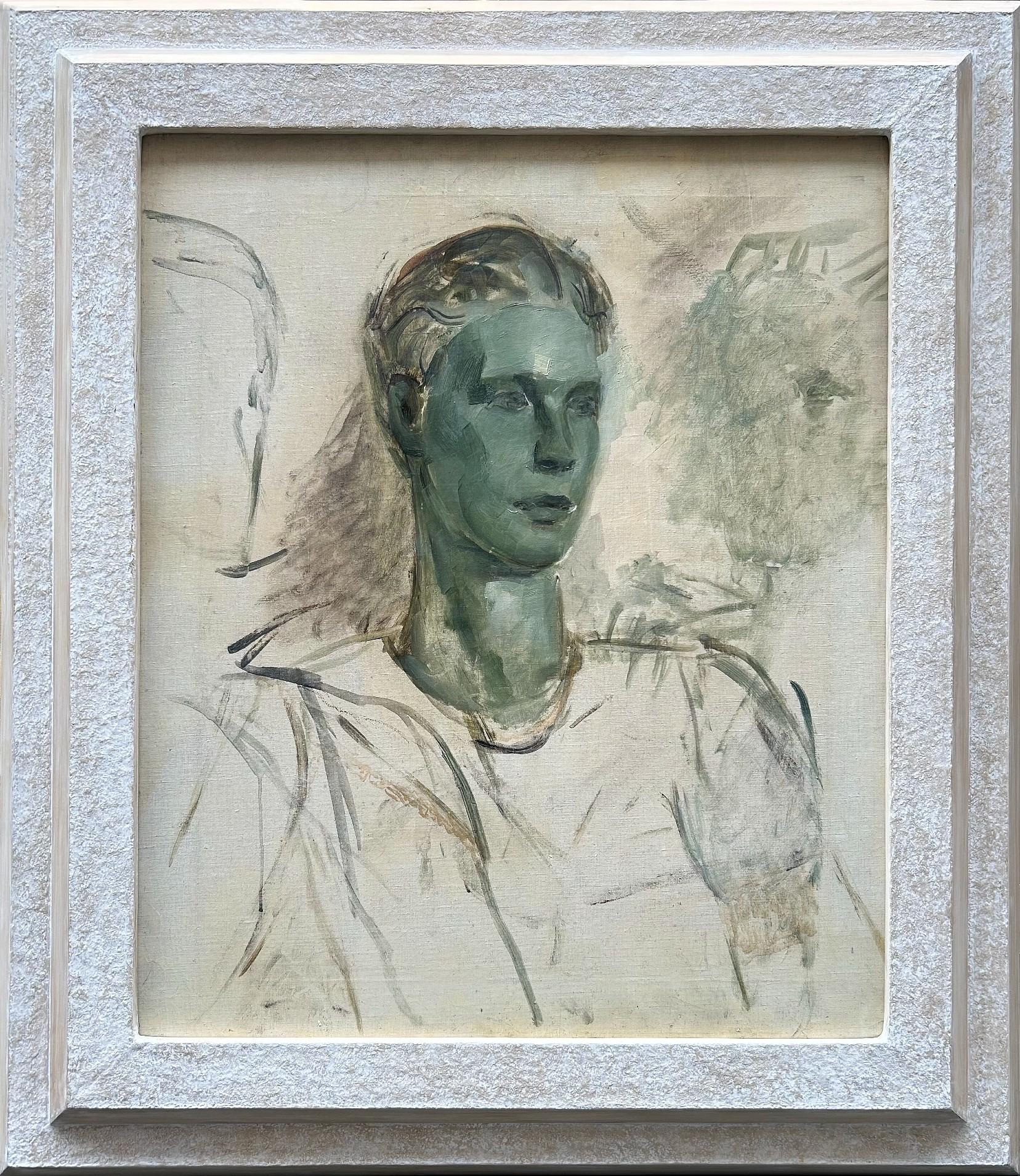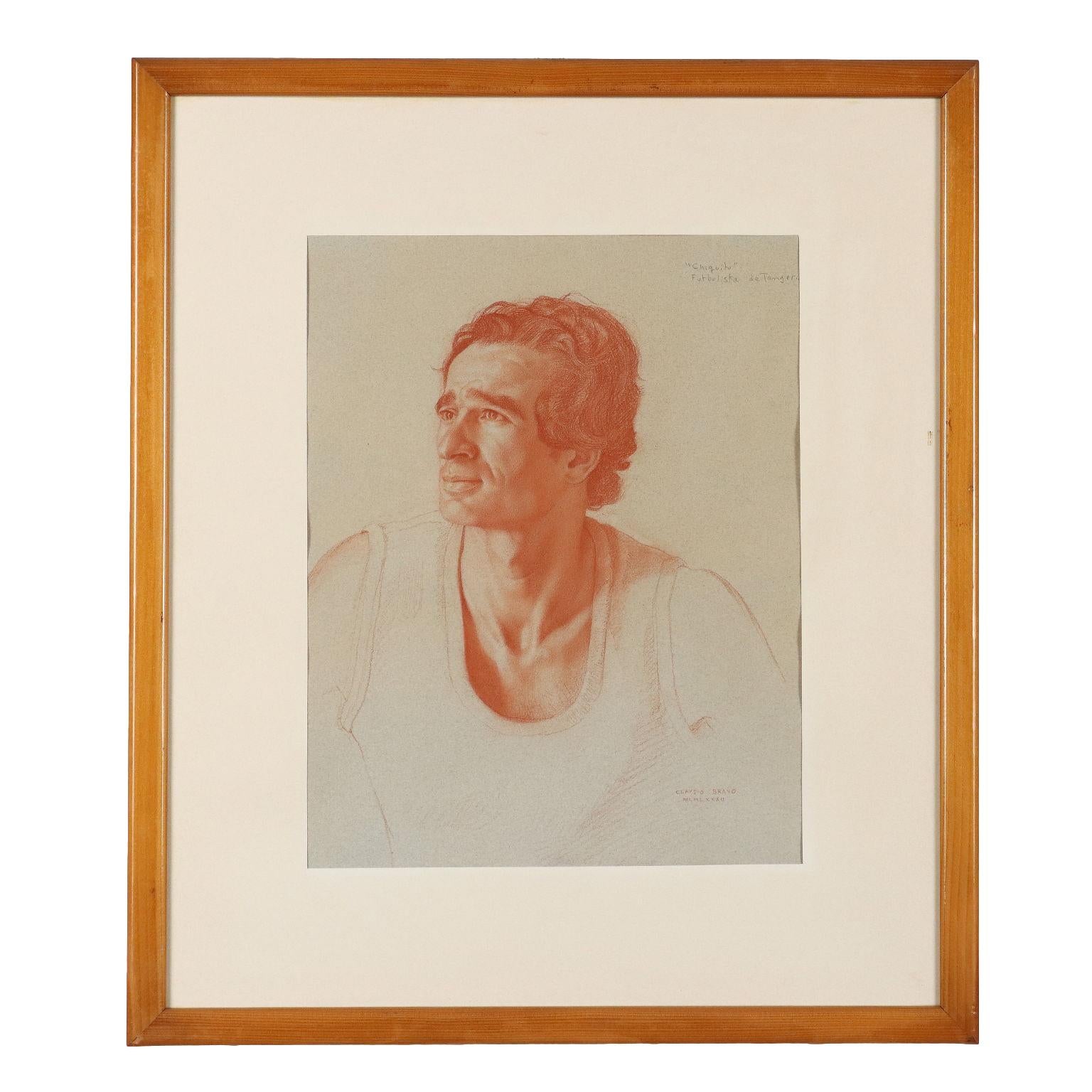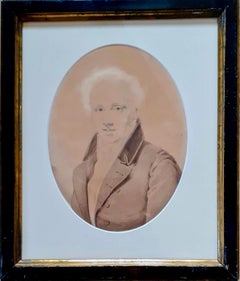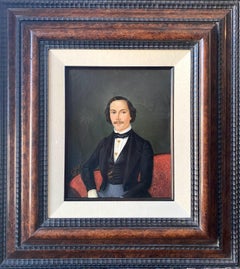Items Similar to Young man in a toga elegant man Latin American hyperrealist Hockney style
Want more images or videos?
Request additional images or videos from the seller
1 of 12
Claudio BravoYoung man in a toga elegant man Latin American hyperrealist Hockney style1974
1974
$7,500
£5,639.40
€6,548.71
CA$10,473.59
A$11,615.99
CHF 6,100.15
MX$142,652.61
NOK 77,222.08
SEK 72,821.46
DKK 48,860.55
Shipping
Retrieving quote...The 1stDibs Promise:
Authenticity Guarantee,
Money-Back Guarantee,
24-Hour Cancellation
About the Item
Superb original drawing in coloured conté pencils, heightened with white on oatmeal coloured vergé paper by Claudio Bravo. The work was created during the artist's Moroccan period, and hence depicts a young, elegant and charismatic man wearing a loose, comfortable toga suitable for life in a Riad. The artwork is signed and dated 1974 in Roman numerals at the lower right. and bears an inventory number and name (of the sitter?) on the verso. The size of the drawing visible in the mount (measured without the frame) is 22 x 16 1/2 inches. Shipped unglazed for safety.
Provenance:
International auction house Pierre Bergé (partner of Yves Saint Laurent)
Private Collection, acquired directly from the artist
Claudio Bravo was born in Chili in 1936 and lived in Tangiers, Morocco from 1972 onwards. He is considered one of the major Masters of the second half of the 20th century. Represented by Marlborough Galleries, works by the artist figure in the collections of the The Baltimore Museum of Art, El Museo del Barrio (New York City), the Honolulu Museum of Art, the Metropolitan Museum of Art, Museo Nacional de Bellas Artes (Santiago, Chile), Museo Rufino Tamayo (Mexico City), Museum Boijmans Van Beuningen (Rotterdam, The Netherlands), the Museum of Fine Arts, Boston, the Museum of Modern Art (New York City), Museum Ludwig (Cologne, Germany), the Palmer Museum of Art (Pennsylvania State University), and the Philadelphia Museum of Art.
- Creator:Claudio Bravo (1936, Chilean)
- Creation Year:1974
- Dimensions:Height: 30.32 in (77 cm)Width: 24.02 in (61 cm)Depth: 0.4 in (1 cm)
- Medium:
- Movement & Style:
- Period:
- Condition:Invisible under the mount, there is toning discolouration around the edges from previous non-archive framing.
- Gallery Location:Norwich, GB
- Reference Number:1stDibs: LU99133093423
About the Seller
5.0
Gold Seller
Premium sellers maintaining a 4.3+ rating and 24-hour response times
1stDibs seller since 2018
90 sales on 1stDibs
Typical response time: 1 hour
- ShippingRetrieving quote...Shipping from: Paris, France
- Return Policy
Authenticity Guarantee
In the unlikely event there’s an issue with an item’s authenticity, contact us within 1 year for a full refund. DetailsMoney-Back Guarantee
If your item is not as described, is damaged in transit, or does not arrive, contact us within 7 days for a full refund. Details24-Hour Cancellation
You have a 24-hour grace period in which to reconsider your purchase, with no questions asked.Vetted Professional Sellers
Our world-class sellers must adhere to strict standards for service and quality, maintaining the integrity of our listings.Price-Match Guarantee
If you find that a seller listed the same item for a lower price elsewhere, we’ll match it.Trusted Global Delivery
Our best-in-class carrier network provides specialized shipping options worldwide, including custom delivery.More From This Seller
View AllPortrait of a Gentleman in a Redingote by student od Jean Louis David drawing
Located in Norwich, GB
An exceptional ink, wash and graphite portrait of a gentleman by Henri-Joseph Hesse, dating from circa 1820, the time of the Bourbon restoration in France. It depicts a dashing figur...
Category
Early 19th Century French School Portrait Drawings and Watercolors
Materials
Paper, Ink, Graphite
The young Bostonian 1858 portrait of a notable gentleman Boston Massachusetts
Located in Norwich, GB
A wonderful portrait of a Bostonian dated 1858, by Leopold Grozelier, the artist best known for creating the first electoral poster ever, bearing the portrait of Abraham Lincoln (186...
Category
1850s American Realist Portrait Prints
Materials
Paper, Laid Paper, Lithograph
Study of an actor, ca 1880 dramatic oil young man staring into fire 19th Century
Located in Norwich, GB
A dramatic, one of a kind oil study. Certainly not your run of the mill 19th Century portait! Depicted is a young man, whose face is brightly lit from what is likely is an open fire....
Category
1880s Academic Figurative Paintings
Materials
Canvas, Oil
The Dandy a Salon in Paris 19th Century portrait of a young man French painting
Located in Norwich, GB
A wonderful depiction of a dapper Parisian dandy, dating from 1848. I love his air of decadence! It is a work by F de Korff, a mysterious French aristocratic portrait artist who had ...
Category
Mid-19th Century Academic Portrait Paintings
Materials
Canvas, Oil
Woman in thought and Child: the page boy intriguing 19th Century Master drawing
By Gustave Jean Jacquet
Located in Norwich, GB
A virtuoso charcoal sketch by the Frech 19th Century master Gustave Jean Jacquet (1846-1904). It depicts a thoughtful woman (or woman in thought?) with her face resting on her hand...
Category
Late 19th Century French School Figurative Drawings and Watercolors
Materials
Charcoal, Laid Paper
Young Beauty American Maurice Sterne rare early 1904 signed original etching
By Maurice Sterne
Located in Norwich, GB
An extremely rare and lovely hand signed etching by American Maurice Sterne, dating from the turn of the century when the artist was working in Paris.
Maurice Sterne, born in 1877 ...
Category
Early 1900s American Modern Portrait Prints
Materials
Etching
You May Also Like
Portrait of a Young Man
By Vito Tomasello
Located in Wilton Manors, FL
Vito Tomasello. Portrait of Wayne Herman, 1971. Pasel on paper, 18 x 24 inches. Signed and dated upper left.
A lifetime NYC resident, Tomasello is best known for his male nude draw...
Category
1970s Realist Figurative Drawings and Watercolors
Materials
Paper, Pastel
Portrait of Young Man
By Vito Tomasello
Located in Wilton Manors, FL
Outstanding male portrait by 20th-century American artist, Vito Tomasello.
Portrait of a young man, c.1950. Pencil on paper, sheet measures 14 x 17 inches.
Excellent condition. S...
Category
1940s Realist Figurative Drawings and Watercolors
Materials
Paper, Pencil
Portrait of Young Man
By Vito Tomasello
Located in Wilton Manors, FL
Outstanding male portrait by 20th-century American artist, Vito Tomasello.
Portrait of a young man, 1963 Pencil on paper, sheet measures 18 x 24 inches.
Crease running diagonally....
Category
1960s Realist Figurative Drawings and Watercolors
Materials
Paper, Pencil
Portrait of Young Man
By Vito Tomasello
Located in Wilton Manors, FL
Outstanding male portrait by 20th-century American artist, Vito Tomasello.
Portrait of a young man, c.1950. Charcoal and pastel on paper, sheet measures an impressive 11 x14 inches...
Category
1940s Realist Figurative Drawings and Watercolors
Materials
Paper, Charcoal
Portrait of a Young Man Oil Painting Celebrated 20th Century Artist
By Oliver Messel
Located in London, GB
Oliver Messel
1904 - 1978
Portrait of a Young Man
Oil on canvas, signed and dated 'Oliver Messel 1930' (on the stretcher)
Image size: 30 x 25 inches (76.2 x 63.4 cm)
Original frame
Oliver Messel was born to Leonard and Maud Messel, née Sambourne, on the 13 January 1904 and was the youngest of three children. The family moved to Nymans, the Messel family home in Sussex, from nearby Balcombe in 1915. The house remained in the family until 1953 when it was bequeathed to the National Trust, following a fire in 1947 which destroyed a large portion of the house.
The Messels originated from a line of German Jewish bankers on Leonard’s side, however, both family lines boast a number of artistic influences, including Maud’s father. Maud was brought up at 18 Stafford Terrace, Kensington (now known as the Linley Sambourne House Museum), amongst collections of antique porcelain and eighteenth-century furniture, and with a host of artistic visitors such as Henry Irving and Oscar Wilde.
Oliver’s own upbringing appears to be influenced by his mother's, as the Messel family were also affiliated with artists and writers and were keen collectors of art, filling their home with textiles, paintings and collections of European and Asian fans from travels abroad. It was amongst such treasures that Oliver, Anne and Linley spent their childhood, in addition to the beauty of Nyman’s extensive gardens.
Oliver was schooled at Eton but rather than going up to university was encouraged by family friends, gallery owner Archie Propert and painter and sculptor Glyn Philpot, to attend art school. In 1922 he enrolled at the Slade School of Fine Art in London, where he studied under Henry Tonks. Here, he met the artist Rex Whistler with whom he remained firm friends until Whistler’s death in WW2.
Upon leaving the Slade in 1924 Oliver was apprenticed to the studio of portrait artist John Wells, where he learnt various Old Master painting techniques, and met artists such as Jacob Epstein, Augustus John and William Orpen.
Whilst at the Slade Oliver developed his interest in Papier Mâché masks, a pastime popular amongst many art students at the time. Whilst apprenticed to artist John Wells several of Oliver’s masks were exhibited at the Claridge Gallery, London, alongside pieces by Whistler and other young artists. These were seen by Serge Diaghilev, director of the Ballet Russes, and Charles B. Cochran, a theatrical producer, both of whom made Oliver offers of work.
His first job in the theatre was creating masks for the Ballets Russes’ Zéphyr et Flore, 1925, designed by the French artist Georges Braque, followed by numerous musical revues for Cochran, including Wake Up and Dream!, 1929, with music by Cole Porter. It was during these revues, working with Porter and Noel Coward, that Oliver also began to design headdresses and costumes. In 1932 he was rewarded with his first full commission to design both costume and sets for Helen!, directed by Max Reinhardt. The production design is still celebrated today for its innovative approach and ground-breaking ‘white on white’ aesthetic, which referenced ‘Greek temples, Rococo drapes, Baroque colonnades and Louis XIV carousels’.
The success of Helen! led to further offers within the theatre including Reinhardt’s version of A Midsummer Night’s Dream at the Old Vic in 1937, starring Vivien Leigh as Titania and Robert Helpmann as Oberon, the Jean Cocteau play The Infernal Machine in 1940, and Christopher Fry’s translation of Jean Anouilh’s Ring Round the Moon, 1950.
One of Oliver’s best-known productions during this period was the Russian ballet The Sleeping Beauty, performed by Sadler’s Wells Ballet in 1946 at the Royal Opera House, Covent Garden. Encompassing over 200 costumes and four set changes, Oliver’s romantic designs were celebrated for bringing colour back to post-war London, and variations on his designs are still used today. Additional designs for the ballet included Comus in 1940, for which he was released from war duties, and Homage to the Queen, choreographed by Frederick Ashton and performed in 1953 for the Queen’s coronation.
His first opera was in 1940 for Mozart’s Die Zauberflöte at the Royal Opera House, followed by a series of productions at the newly founded Glyndebourne Opera House in Sussex, for which Oliver also designed the proscenium arch. He triumphed in 1956 designing a season of four different productions for their Mozart bicentennial, also providing illustrations for the programme covers.
His popularity also spread beyond theatre to film, were he worked on over eight different feature films including Romeo and Juliet, 1936, directed by George Cukor. During a three-month research trip to Italy Oliver collected over 3,000 reference images including postcards of artwork by Piero della Francesca, Giovanni Bellini and Leonardo da Vinci, along with prints and photographs of textiles and architectural features.
A production of Gabriel Pascal’s Caesar and Cleopatra, 1946, starring Vivien Leigh and Claude Rains, was celebrated for Oliver’s ability to recreate the opulence and luxury of ancient Egypt under the constraints of wartime rationing. Such was his skill that Vivien Leigh in a letter to Oliver declared that “I have of course told Pascal that nobody in the world must do the costumes except you.” He was later nominated for an Academy Award for his work on his final film Suddenly, Last Summer, 1959; an adaptation of Tennessee Williams’ American Southern Gothic mystery.
Having started his artistic career as a portrait apprentice, capturing the faces of family and friends, Oliver continued to develop this practice until the end of his life. His style is said to have been influenced by Glyn Philpot, the Messel’s family friend who encouraged Oliver from an early age in his pursuit of art and design. His most prolific period came in the 1950s during which he produced over 50 portraits, which were shown in exhibitions in New York, London and Barbados.
The exhibitions included both well-known faces and anonymous sitters captured on Oliver’s travels, and a number of these works have entered private collections. He continued to paint after moving to the Caribbean in 1966, capturing society figures and the rich and famous including fashion designer Carolina Herrera and Bianca Jagger. His style remained unchanged throughout his career, using the same soft painterly strokes and subtle palette as in his theatre designs.
By far his greatest contribution in addition to theatre and film was Oliver’s interior and architectural designs.
Another, much celebrated commission included Rayne shoe shop in Old Bond Street, where he created jewel-like interiors using the same practice of scaled models as his set designs. Other notable interior designs include those for Norwich and Bath Assembly Rooms, Flaxley Abbey in Gloucestershire, Rosehill Theatre in Cumbria and the Reader’s Digest offices in Paris.
However, upon moving to Barbados in 1966, Oliver embraced a new career envisioning architectural concepts for private houses, hotels and public buildings, utilising his experience with interior design to furnish them with bespoke items of furniture and textiles. His first project was Maddox, the deserted eighteenth-century plantation house bought by himself and his partner Vagn Riis-Hansen in 1964. The existing building and gardens were remodelled to Oliver’s designs embracing an inherent theatricality with views out to sea. These were framed by terraces and verandas which extended out from the living rooms creating what is often referred to as a Caribbean style of ‘indoor-outdoor’ living. For the woodwork he used a shade of green that is now known as ‘Messel green’ and often associated with the island of Barbados.
Oliver was born into a wealthy family; he travelled extensively and was exposed to art and culture from a young age. A privileged youth, his name is often mentioned amongst the ‘Bright Young Things’, for whom costume parties at country houses and jaunts to Europe on a whim became a thing of fable. This informal group included people such as Cecil Beaton (a life-long friend whom Oliver first met at Eton), Lord Berners, Noel Coward, John Betjeman, Harold Acton, Nancy Mitford, Edith Sitwell, Stephen Tennant...
Category
20th Century Modern Portrait Paintings
Materials
Canvas, Oil
Chiquito Futbolista de Tanger 1982
Located in Milan, IT
Sanguine on paper. Signed and dated in Roman numerals at lower right. In the upper right corner is the title.
Claudio Bravo Camus was a Chilean painter best known for compositions (...
Category
1980s Contemporary Portrait Drawings and Watercolors
Materials
Paper
More Ways To Browse
Latin Artist Painting
Latin American Paintings
Marlborough Gallery
Pencil Portrait Man 20th
El Morocco
Tangier Paintings
Tangier Portrait
Writer Art
Layered Paper Art
California Prints
Contrast Abstract Art
Original Illustration
Fashion Photography Print
Black Woman
Westal Paintings
Antique Etchings
Yellow Abstract Art
Architectural Abstract Art



